
|
Sale 104
June 10-13 2018 Pre Long Beach Sale
| Roman Imperatorial Period |
| |
| |
| Lot |
Photo |
Description |
Realized |
Lot 3246 |
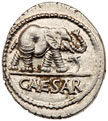 |
Julius Caesar, as Dictator, 49-44 BC. Silver Denarius (3.94g). Military mint in northern Italy, 49 BC. Elephant advancing right, trampling horned serpent; CAESAR in exergue. Reverse: Pontifical implements: ladle (simpulum), sprinkler (aspergillum), axe (securis), and pontiff's cap (apex). Crawford 443/1. CRI 9. Sydenham 1006. RSC 49. Sharply struck in bright metal on an exceptionally broad flan, and fully lustrous. Superb Extremely Fine. Estimate Value $1,000 - 1,400
This was the first of Julius Caesar's coin types, struck shortly after he crossed the Rubicon in January of 49 BC. The symbolism of the obverse (if indeed it is the obverse) has been subject to some debate, but most probably the elephant represents Caesar and the serpent his political enemies. Alternatively, the "serpent" could be a carnyx, a Gallic war trumpet in the shape of a dragon, which would make the obverse symbolic of Caesar's recent victories in Gaul. The pontifical emblems on the reverse are easier to interpret, being a direct reference to his position of Pontifex Maximus, chief priest of the Roman state religion. The issue was immense, possibly as many as 22.5 million denarii, and certainly used to pay the soldiers of the legions loyal to Caesar, and to induce those backing his foes to switch sides. The suddenness and speed of Caesar's march down the Italian peninsula caught the Senate and their champion Pompey totally off-guard, forcing them to flee Rome in haste, leaving the state reserves of silver bullion still in place beneath the Temple of Saturn. This proved to be a fatal error and provided the specie from which Caesar struck his coinage and financed his successful campaign for supremacy.
View details and enlarged photos
| Realized
$2,220 |
Lot 3247 |
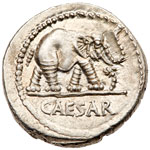 |
Julius Caesar. Silver Denarius (3.98g), 49-44 BC. Military mint traveling with Caesar in northern Italy, 49 BC. Elephant advancing right, trampling horned serpent, CAESAR in exergue. Reverse: Pontifical implements: ladle (simpulum), sprinkler (aspergillum), axe (securis), and pontiff's cap (apex). Crawford 443/1; CRI 9; RSC 49. Near-perfect strike and centering on a broad, round flan for this highly popular type. Superb Extremely Fine. Estimate Value $1,000 - 1,400
View details and enlarged photos
| Realized
$1,980 |
Lot 3248 |
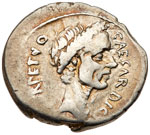 |
Julius Caesar. Silver Denarius (3.77 g), 44 BC. Rome. L. Aemilius Buca, moneyer. CAESAR DICT [PER]PETVO, laureate head of Julius Caesar right. Reverse: L BVCA, winged caduceus and fasces in saltire; globe, in angles, axe, globe, and clasped hands. Crawford 480/6; Alföldi type XIII; HCRI 103; Sydenham 1063; RSC 25. Rare. Excellent portrait. Toned. Very Fine. Estimate Value $2,000 - 2,500
View details and enlarged photos
| Realized
$2,520 |
Lot 3249 |
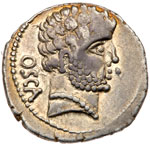 |
Domitius Calvinus. Silver Denarius (3.85 g), Proconsul and Imperator in Spain 39-36 BC. Osca. OSCA behind, bare head of Hercules right, wearing necklace. Reverse: DOM COS ITER IMP, priestly emblems: simpulum, aspergillum, securis, and apex. Crawford 532/1; HCRI 342; Sydenham 1358; Burgos 1509. Lightly toned with areas of luster present. Choice Very Fine. Estimate Value $500 - 600
View details and enlarged photos
| Realized
$660 |
Lot 3250 |
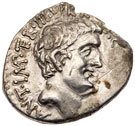 |
Mark Antony, Imperator and Triumvir, 44-30 BC. Silver Denarius (3.61g). Military mint in Greece or Syria, 37-36 BC. ANT IMP TER III VIR R P C, bare head of Antony right. Reverse: AV-GVR on either side of trophy consisting of cuirass, corselet, two oblong shields, and helmet mounted on pole, with two round shields and two spears at base. Crawford --; Sydenham --; RSC --; CRI --; see NAC 100 (29 May 2017), lot 399 and Jesus Vico 150 (1 March 2018), lot 694 for the only two other examples yet offered at auction. Deeply struck on a somewhat ragged flan, with one edge chipped, graffiti in obverse field, areas of slight double-striking. Nevetheless extremely rare; quite desirable despite the flaws, and the net grade provided here seems appropriate. Nearly Extremely Fine. Estimate Value $500 - UP
This appears to be a variant of Crawford 536/1 and CRI 269, which features the same basic design but has AVGVR part of the obverse inscription and IMP TER on the reverse; this example reverses this formula. The type was struck to celebrate the victories of Antony's legate Vetidius against the Parthian invasion led by rebel Roman expat Quintus Labienus. This variety was apparently unknown until two other examples appeared at auction in 2017 and earlier this year; our specimen would appear to be only the third known example.
View details and enlarged photos
| Realized
$1,050 |
Lot 3251 |
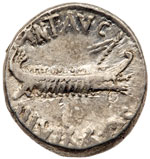 |
Mark Antony, Silver Denarius (3.83g), 31-30 BC. Legionary issue, mint moving with Antony in Greece (Aegae or Patrae), 32-31 BC. ANT AVG-III VIR R P C, war galley under oar right with triple ram prow and scepter tied with fillet. Reverse: LEG-II, legionary eagle (aquila) between two standards (signa). Crawford 544/14. CRI 349. RSC 27. Lightly toned, with flashes of luster in fields around devices. Very Fine. Estimate Value $300 - 350
View details and enlarged photos
| Realized
$216 |
Lot 3252 |
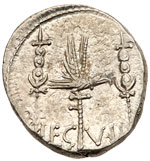 |
Mark Antony. Silver Denarius (3.38 g), 32-31 BC. Legionary type. Patrae(?). ANT AV[G] III VIR R P C, praetorian galley right. Reverse: LEG VII, legionary eagle right between two standards. Crawford 544/21; CRI 358; Sydenham 1225; RSC 35. Luster present. Choice Very Fine. Estimate Value $500 - 600
View details and enlarged photos
| Realized
$810 |
Lot 3253 |
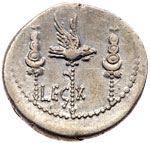 |
Mark Antony, Silver Denarius (3.53g), 32-31 BC. Legionary issue, mint moving with Antony in Greece (Aegae or Patrae), 32-31 BC. ANT AVG-III VIR R P C, war galley under oar right with triple ram prow and scepter tied with fillet. Reverse: LEG - X, legionary eagle (aquila) between two standards (signa). Crawford 544/24; CRI 361; RSC 38. Faint scratches in reverse fields, otherwise cleanly struck and lightly toned. Very Fine. Estimate Value $300 - 350
View details and enlarged photos
| Realized
$276 |
Lot 3254 |
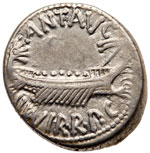 |
Mark Antony, Silver Denarius (3.71g), 32-31 BC. Legionary issue, mint moving with Antony in Greece (Aegae or Patrae), 32-31 BC. ANT AVG-III VIR R P C, war galley under oar right with triple ram prow and scepter tied with fillet. Reverse: LEG - XI, legionary eagle (aquila) between two standards (signa). Crawford 544/25; CRI 362; RSC 39. Lightly toned. Very Fine. Estimate Value $300 - 350
View details and enlarged photos
| Realized
$360 |
Lot 3255 |
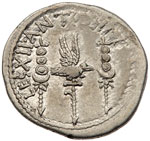 |
Mark Antony. Silver Denarius (3.09 g), 32-31 BC. Legionary type. Patrae(?). ANT AVG III VIR R P C, praetorian galley right. Reverse: LEG XII ANTIQVAE, legionary eagle right between two standards. Crawford 544/9; HCRI 363; Sydenham 1231; RSC 40. Lightly toned. Very Fine. Estimate Value $500 - 600
View details and enlarged photos
| Realized
$480 |
Lot 3256 |
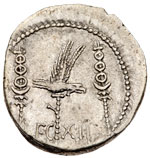 |
Mark Antony, Silver Denarius (3.53g), 32-31 BC. Military mint in Greece (Patrai or Aigai?), 32-31 BC. ANT AVG - III VIR R P C, war galley under oar right with triple ram prow and scepter tied with fillet. Reverse: LEG - XII, legionary eagle (aquila) between two standards (signa). Crawford 544/26; RSC 41; CRI 365. Decent strike and attractive light toning. Choice Very Fine. Estimate Value $400 - 500
The Aquila, or Eagle, was a totemic symbol for the Roman legions going back nearly to the foundation of the city in the 8th century BC. In the early Republic, the eagle was one of five symbols used by the Consular armies, the other four being a wolf, a man-faced ox, an open hand, and a horse; all of these were made of metal and hafted on poles to be carried by designated soldiers called signiferi. Gaius Marius (consul 106-100 BC and 83 BC) is said to have eliminated the other animals, retaining only the eagle, which in the Republic was usually crafted of silver. The Aquila was thought to be imbued with the genius, or spirit, of the legion, and was normally stored in a temple called the Sacrellum, along with other legionary standards. When a legion went on campaign, the eagle was carried at the head of the marching column by a double-pay officer called the Aquilifer, a position of immense prestige.
View details and enlarged photos
| Realized
$552 |
Lot 3257 |
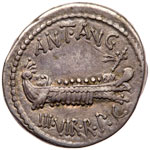 |
Mark Antony, Silver Denarius (3.70g), 32-31 BC. Legionary issue, mint moving with Antony in Greece (Aegae or Patrae), 32-31 BC. ANT AVG-III VIR R P C, war galley under oar right with triple ram prow and scepter tied with fillet. Reverse: LEG - XVI, legionary eagle (aquila) between two standards (signa). Crawford 544/31; CRI 372; RSC 48. Well centered, with full legends both sides, with even gray toning and a hint of iridescence. Choice Very Fine. Estimate Value $400 - 500
View details and enlarged photos
| Realized
$456 |
Lot 3258 |
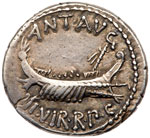 |
Mark Antony. Silver Denarius (3.82g), 32-31 BC. Legionary issue, mint moving with Antony in Greece (Aegae or Patrae), 32-31 BC. ANT AVG-III VIR R P C, war galley under oar right with triple ram prow and scepter tied with fillet. Reverse: LEG XXI, aquila (legionary eagle) between two signa (standards).Crawford 544/37; CRI 381; RSC 58. Well centered on a nice round flan, with pleasing old cabinet toning. Nearly Extremely Fine. Estimate Value $1,000 - 1,200
Mark Antony's extensive legionary issues, struck to finance his unsuccessful civil war against Octavian, honored the 25 Roman legions and several other military units that formed his vast army assembled in Greece for the invasion of Italy in 32 BC. The coins were struck in slightly base metal, which meant they continued to circulate within the Empire for decades and centuries to come (merchants preferring to keep handing them off in change rather than hoarding them with denarii of better metal).
View details and enlarged photos
| Unsold |
Lot 3259 |
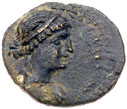 |
Mark Antony and Cleopatra, AE 21 (4.71g), 36-31 BC. Struck at Coel-Syria, Chalkis. Dated regnal years 21 (Egypt) and 6 (Phoenicia) of Cleopatra (32/1 BC). [BACIΛICCHC] KLEOΠA-TPA, diademed and draped bust of Cleopatra right, hair in parallel cornrows gathered into chignon at nape of neck. Reverse: ETOYC KA TOY KAI E TEAC NEωTEPAC, bare head of Mark Antony right. Svoronos 1887. RPC 4771. SNG Copenhagen 383. Obverse a tad off-center, otherwise a pair of sharp portraits of history's most famous power couple, with a pleasing brown patina and light earthen fields. Extremely Fine. Estimate Value $700 - 800
At the famous "donations of Alexandria" in 36 BC, among the many "gifts" illegally bestowed by Antony on Cleopatra was sovereignty over the lands of Coele Syria, now the Beqaa Valley in Lebanon, with its profitable trade in cedar wood and exotic spices. This bronze coin of a city under Cleopatra's control, Chalkis in Coel-Syria, is dated to the sixth year of her sovereignty in the region (32/1 BC). While it hugely increased her wealth and prestige, it also put Cleopatra in emnity with Herod the Great of Judaea, who coveted the same luxury markets. Originally a supporter of Antony, Herod eventually "jumped ship" to join Octavian when civil war broke out in 32 BC.
View details and enlarged photos
| Realized
$1,680 |
Lot 3260 |
 |
Mark Antony and Cleopatra. Æ23 (6.27 g), ca. 36-31 BC. Chalcis, Dated RY 21 (Egyptian) and 6 (Phoenician) of Cleopatra (32/1 BC). Draped bust of Cleopatra right, wearing stephane. Reverse: ?TO?C ?? [??? KAI G?]AC N?WT?PAC, bare head of Mark Antony right. RPC 4771. SNG Copenhagen 383 (Phoenicia). HGC 9, 1451. Lovely dark green patina. Scarce. Choice Very Fine. Estimate Value $500 - 600
View details and enlarged photos
| Realized
$1,110 |
Lot 3261 |
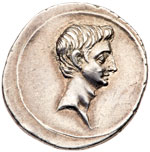 |
Octavian, as Sole Imperator, Silver Denarius (3.78g), 30-29 BC. Uncertain Italian mint (Brundisium and Rome?) Bare head of Octavian right, within linear circle. Reverse: Octavian in car of facing triumphal quadriga atop single-span triumphal arch with IMP CAESAR inscribed on architrave. RIC I, 267; RSC 123. Minor surface marks, otherwise a remarkable specimen, boldly struck on a broad flan of sound metal, with attractive light toning over residual luster. Superb Extremely Fine. Estimate Value $2,500 - UP
This is one of the most starkly beautiful denarii of the imperatorial era, omitting as it does all legends save for the inscribed architrave of the triumphal arch on the reverse. This is the so-called Actian Arch erected to celebrate Octavian's victory at Actium over his rival and former fellow-triumvir Marcus Antonius in 31 BC.
View details and enlarged photos
| Realized
$2,880 |
Lot 3262 |
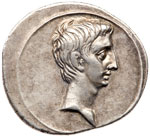 |
Octavian, as Sole Imperator, Silver Denarius (3.77g), 30-29 BC. Uncertain Italian mint, ca. 30-29 BC. Bare head of Octavian right. Reverse: Naval trophy consisting of cruirassh; helmet, shield, two javelins, and two rudders posted on ship's prow right; IMP CAESAR across field. CRI 419. RIC 265a. RSC 119. Rare. Well struck on a nice large flan and lightly toned. Extremely Fine. Estimate Value $1,000 - 1,300
Struck in the aftermath of Octavian's naval victory at Actium, this attractive denarius type depicts the arms and equipment of a Roman marine. Armor and weaponry used by shipborne soldiers was specially designed so as not to drag a soldier to his doom should be be dumped into the water. The muscle-type cuirass was lighter and easier to get out of than the chain mail widely used by land-based soldiers; likewise the smaller hexagonal shield and lightweight javelins were designed for shipboard use.
View details and enlarged photos
| Unsold |
Lot 3263 |
 |
Octavian, as Sole Imperator, Silver Denarius (3.69g), 30-29 BC. Southern or central Italian mint, c. 29-27 BC. Bare head of Octavian right. Reverse: Facade of the Curia Julia (Roman Senate House), IMP CAESAR on the architrave, porch supported by four short columns, statue of Victory facing at peak of roof, flanked by statues of standing figures, turned inwards, at the extremities of the architrave. CRI 421. RIC 266. RSC 122. Tiny circular banker's mark in right obverse field, otherwise an exemplary example of this scarce architectural issue, possessing a sensitive portrait of Octavian, with residual luster around devices. Choice Very Fine. Estimate Value $600 - 700
View details and enlarged photos
| Realized
$750 |
Lot 3264 |
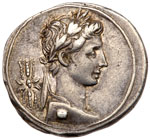 |
Octavian, as Sole Imperator. Silver Denarius (3.59 g), 30-29 BC. Uncertain mint in Italy. Laureate bust of Octavian as Jupiter Terminus, right; behind, winged thunderbolt. Reverse: IMP CAESAR across field, Octavian seated left on curule chair, holding Victory. RIC 270; HCRI 427; RSC 116. Rare. Well struck and perfectly centered. Fine style portrait. Lightly toned. Choice Very Fine. Estimate Value $1,300 - 1,500
View details and enlarged photos
| Realized
$1,440 |
Lot 3265 |
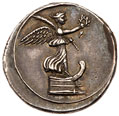 |
Octavian, as Sole Imperator, Silver Denarius (3.93 g), autumn 30 BC. Uncertain Italian mint (Rome?). Victory standing right on prow, holding wreath and palm. Reverse: IMP CAESAR in exergue, Emperor, holding branch and reins, driving triumphal quadriga right. RIC 264; HCRI 416; BMC 617; RSC 115. Sharply struck with lovely old cabinet toning. A splendid example. Removed from an NGC slab graded AU; Strike: 5/5, Surface: 4/5. Estimate Value $1,250 - 1,500
From the Dr. Patrick Tan Collection.
View details and enlarged photos
| Realized
$1,860 |
Lot 3266 |
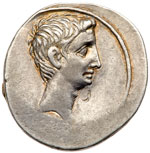 |
Octavian, as Sole Imperator, Silver Denarius (3.68 g), 30-29 BC. Uncertain Italian mint, perhaps Rome. Bare head right / Trophy set on prow of galley right; crossed rudder and anchor at base. RIC 265a; BMC 625; HCRI 419; RSC 119. Bare head of Octavian right. Reverse: IMP CAESAR across field, trophy set on prow of galley right; at base, crossed rudder and anchor. RIC 265a; HCRI 419; BMC 625; RSC 119. Scarce. Wonderful portrait. Tiny banker's mark below chin, an area of softness below the bust of Octavian and on the corresponding section of the reverse. Lightly toned. Choice Very Fine. Estimate Value $300 - 400
View details and enlarged photos
| Realized
$480 |
Lot 3267 |
 |
Octavian. Triumvir and Imperator. Silver Denarius (3.88 g), prior to 27 BC. Pergamum. CAESAR DIVI F COS VI, bare head of Octavian right; below, small capricorn right. Reverse: AEGVPT[O] above, CAPTA below, nile crocodile right. RIC 545; HCRI 432; BN 928-30; BMC 653; RSC 4. Rare. Wonderful artistic portrait, lightly toned with areas of luster present. Softness on the crocodile. About Extremely Fine / Very Fine. Estimate Value $900 - 1,000
View details and enlarged photos
| Realized
$1,800 |
Lot 3268 |
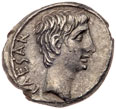 |
Octavian, as Sole Imperator, Silver Quinarius (1.53g), 28 BC. Italian mint (Brundisium or Rome?), [IMP] CAESAR, bare head of Octavian right. Reverse: ASIA RECEP[TA], Victory standing facing on cista mistica, head left, holding wreath in right hand and long palm with her left, flanked by two interlaced snakes with heads erect. BMC 647. Cohen 14. RIC 276. Rare, with a pleasing portrait and uniform light gray toning. Superb Extremely Fine. Estimate Value $500 - 600
View details and enlarged photos
| Realized
$288 |
|
|